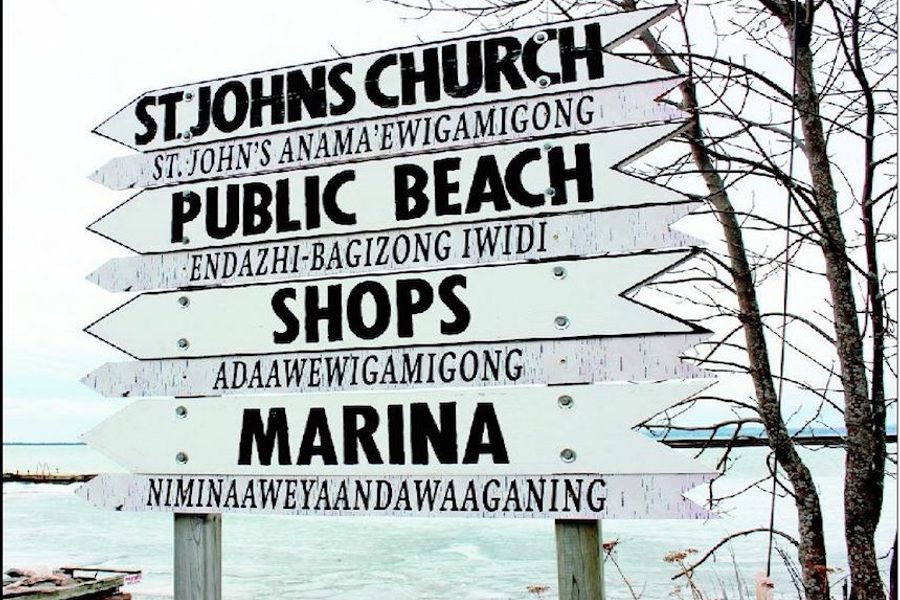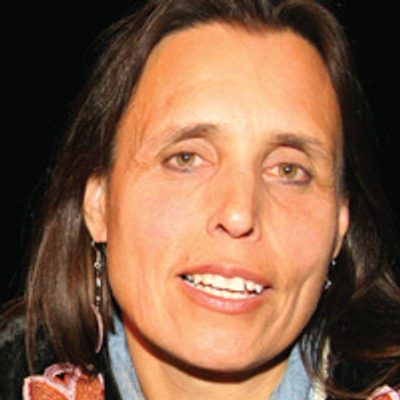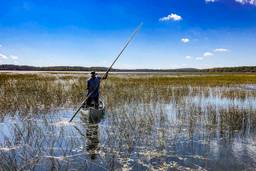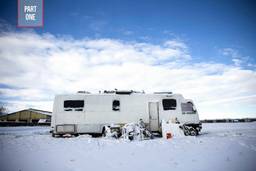
“Originally all the inhabitants of the earth (Chippewa Indians) who were to learn the Mide lived on Madeline Island, in Lake Superior, in that portion of the country. They were selected by the divine Manido to be taught the Mide religion…”
From the “The Origin of the Mide,” as documented in the 1905 compendium of oral Ojibwe tradition, Nawajibikokwe.
It was like reading about Atlantis. That is my earliest memory of the Island. Moningwunakauning Minis — “home of the golden-breasted woodpecker” — now called Madeline. It is the Anishinaabe homeland, a Mecca for the Ojibwe.
This is the place where the Creator and prophets instructed our people to move. In the 2lst century, it is a place where the complexity of restoring a multi-cultural society in a sacred land is being revealed. The question is, “How do we do so with grace?”
Akawe—In the beginning
Long ago, during the time of prophecy, the Anishinaabeg were told to follow the Migis shell which appeared in the sky. And from our eastern homeland, along the great water, we would stop seven times, ending finally at Moningwunakauning Minis.
It is here on this island that we flourished and spread our wings as Anishinaabe people. Moningwunakaauning Minis served as the southern capitol of the Anishinaabe nation, which now stretches across what are four American states and three Canadian provinces.
Moningwunakaauning Minis became a center of our Midewewin Society, our powerful religion, which connects us to the four layers beneath the earth and the four layers above. It is here on this island that we refined our lacrosse game, and where the Anishinaabe women perfected our game of shinny, a sort of Ojibwe broomball. It is here that we launched fishing boats, collected berries on the many surrounding islands and became the largest inland naval force in North America — dominating the Great Lakes with trade, agriculture and fishing.
We lived on the Island for 300 years before we were “found.” The French found us, and, as European empires do, they built a fort. Gotta have a fort. That was in 1693, the fort was La Pointe.
Our treaties were signed at La Pointe, allowing access to the Great Lakes for miners, loggers and settlement. It was cheaper for the fledgling United States to treaty for land than to fight wars. The western Indian wars cost the United States millions of dollars. Treaties were the equally treacherous, less-expensive answer. An Indian Agent at La Pointe once calculated that millions of acres of Ojibwe territory were acquired through treaties for less than 10 cents an acre.
The value of the fisheries, maple syrup, wild rice, agriculture and fur from our treaty lands was incalculable. The copper taken from our homelands alone was worth $5.72 billion based on 1971 markets.
Wanishiniwag—They Disappear
Four treaties were signed by the United States with the Ojibwe, each providing for mining in Anishinaabeg territory. These treaties, the 1837, 1842, 1854, and 1855, covered both the Keweenaw Peninsula of Michigan’s Upper Peninsula and the Mesabe (Sleeping Giant) iron-ore belt in northern Minnesota.
As early as 1849, copper production in the Keweenaw Peninsula of Anishinaabe territory led the world. Similarly, beginning in 1890, mining in the Mesabe Range accounted for 75 percent of all U.S. iron ore production.
Greed is an amazing driving force in the history of America. Not content to steal our wealth, some decided to steal our lives. In 1850 and 1851, four prominent officials of President Zachary Taylor’s administration conspired to force the Anishinaabeg onto lands in Minnesota Territory. In 1850, while our ancestors gathered to collect their treaty payments, the Indian Agents moved the meeting place from Madeline Island to Sandy Lake, in present day Minnesota.
Four thousand Ojibwe canoed to Sandy Lake that autumn. They arrived on the payment date, fatigued and hungry, only to find no one there to distribute the supplies. Wild game was scarce, fishing was poor and high water had wiped out the wild rice crop. Ill-equipped and confined to a waterlogged area, disease, exposure and starvation ravaged the Ojibwe, killing three to eight people each day.
In early December, with over a foot of snow on the ground and the waterways frozen over, the Ojibwe finally received their annuities. With 170 people already dead, they started on the bitter trail back towards our land here at Gichi Gummi, the great lake, now known as Superior. Another 230 people died on that frigid journey, later called the Wisconsin Death March or the Sandy Lake Tragedy.
Those who survived returned to our homelands and the public outcry forced the suspension of the removal order.
Wanishin—Lost
After the Sandy Lake Tragedy, the Ojibwe were moved to reservations throughout the region, but we never forgot our place. The Ojibwe word for reservation is ishkonjigan, or leftovers. It is not a homeland. The reservation era was the beginning of an immense trauma for the Anishinaabeg people.
We were sent away from our beloved Island. Edith Leoso, the Tribal Historic Preservation Officer for the Bad River band of Ojibwe, remembers what is told about Moningwunakauning Minis:
We left that island with the understanding that we would never hold lodge there again. Eddie Benton (of the Three Fires Midewiwin Society) talks about how the old people who had to leave built this huge bonfire…and then we left. They say that when we got to Bad River we could still see the fire…We wanted to remember where our homeland was at, so that when we did ceremonies, we would always know this… that fire, it was also a part of letting go. Yet knowing our connection. Perhaps it was part of the detachment. To try and forget and cope with the trauma of leaving.
Three decades later, most of Madeline Island was privately held and divided into homesteads. In 1854, the Ojibwe received a small guarantee that land at the North End would remain for the people, some 200 acres that were reserved fishing grounds.
The Complexity of Wealth
The wealth amassed from our territory would also come to the Island. In the 19th century, it came to the Island in the form of summer homes for some of the most affluent families of the Great Lakes, many from the same families who had originally created the mining and lumber companies from our lands.
Ironically, some of the poorest residents of Wisconsin live next to one of the state’s wealthiest townships — at least during the summer. To be specific, on the Red Cliff reservation on the mainland, two-and-one-half miles from the Island, unemployment hovers around 50 percent; 65 percent of the population lives below the poverty level; the median household income is about $8,000 and the estimated per capita income is $1,450. A new casino, Legendary Waters, recently opened on the reservation that brings some new money and probably some more tourists. But, frankly, it does not change the structure of poverty and wealth.
All in all, jobs are scarce, and many jobs during the summer involve building or cleaning homes for those who can afford to live on the Anishinaabe homeland. A really nice house on Madeline Island sold last year for $1.79 million. There are some inexpensive building lots offered at $50,000, and quite a bit in between.
There are a dozen or so beach homes built on the small amount of land that was reserved for the Ojibwe as our fishing grounds — the 200 acres on the North End. The Bureau of Indian Affairs first leased these lands out in 1967 as a tribal moneymaking enterprise. It became the Amnicon Bay Association consisting of 12 or so families.
Those leases expire in 2017, which invariably is a heated topic of discussion with the new residents of the Island. Mary Annette Pember, a Bad River Ojibwe journalist, took a trip to the North End of the Island in the summer of 2013 to talk to some of the leaseholders of the Amnicon Bay Association. She was surprised that one couple, Amy and Harry Funk, bought a home only seven years before the possible end date of their lease in 2017. During an interview with Mary, Harry Funk explained,
The people in town said we were crazy to buy a cabin out here, the tribe is taking the land back. But if we did something silly, we did something silly. We love it here. This bay is my spiritual renewal and I’ll be sorry to lose it if we have to move. But I’m just happy we’ve had the time that we’ve had here.
The Funks, feel a relationship to the Island like all others. Mary noted, “The Funks and other cabin owners expressed gratitude and acceptance, albeit reluctantly, about the land and the possibility of it returning to the tribe.”
Island Culture
Separated by the deepest of waters in a great inland sea, it is very possible to believe you are alone on the Island. The world is distant. That is why people come to Madeline Island — for refuge — and that is how an island culture — or subculture — emerges.
Summer homes and a tourism economy came to dominate. Farming and fishing subsided while the four remaining farms disappearing one by one, until the Island became an importer of almost every sort of food that would be consumed there.
In 1850, 40 residents of the Island population were Cadottes — a Métis, French and Ojibwe fur trading family. In 2015, around 40 residents of the Island are Nelsons, families of enterprising Swedes who own a stake in the Madeline Island Ferry Line, a construction company, acres of land, Tom’s Burned Down Café and other points of interest. The year round residents, numbering maybe 250, are by and large really nice people.
In some ways there were two classes of people who came to the Island, the very wealthy and those who care for them. This does not mean that the Island is not beloved by both, but it does result in interesting land use policy decisions.
The Yacht People
America has an excellent case of historic amnesia. But it turns out that even if you do not remember history, it does not mean it did not happen. The Ojibwe were not mythical beings, nor were we Phoenicians. We were and are a living community of 250,000 people. We continue to live in our homeland, just not on our beloved island.
Many of the yacht people forgot about the Ojibwe. This is made evident by the marina of the Madeline Island Yacht Club that adjoins the cemetery where Chief Buffalo, one of our greatest Chiefs, is buried in a modest grave among about l00 other Ojibwes who were allowed to be buried in the Catholic Indian cemetery.
The initial marina was dredged prior to any regulation or oversight. It was an ambitious moment for the Yacht Club when, in 1984, they decided to expand the berths to allow for more yachts. As it turns out, the entire area surrounding the marina is likely full of Ojibwe remains.
Paul DeMain, from the Lac Courte Orielles reservation, points to a place next to a monument erected by the Ojibwe near the marina, and says:
That was when they ran into the ancestor, an old man in a dugout canoe, right in the middle of the dig. … The ancestor was there, and here is where we remember those who left for Sandy Lake.
Portions of the island of been included on the list of National Register of Historic Places, but these include a small fraction of the traditional cultural landscape. A memorandum requiring the Army Corp of Engineers and La Pointe officials to consult tribal elders prior to development projects has also been proposed by the Advisory Council on Historic Preservation (ACHP). This federal designation, from an Ojibwe perspective, will afford more protection for tribal history on the Island.
All of this is unfortunate if you are an ambitious developer. There has been a set of ongoing proposals to expand the marina, each of which has been turned down for a number of reasons. This is, in part, what happens when one culture decides it wants to build on top of another living culture.
Moningwunakauning Minis 4.0
A couple of summers ago, our family built the first residential summer wigwam on the Island in probably 100 years, maybe more. It’s called Giiwedinong, or the place we come home to. It was an interesting meeting with the zoning officials one night — all nice people, many of them Nelsons. “I am not sure this complies with the uniform building code,” the zoning director, Jennifer Croonberg, earnestly explained to me. I smiled and said, “I believe it precedes the uniform building code.”
The wigiwam is not built on the tribal land in the far north of the Island, but on the edge of town within bike-riding distance for young kids. That is because we too are a part of the community. The tribal presence is growing stronger, and meetings and ceremonial gatherings have been held with increasing frequency on the Island. This year, for the first time, an Ashland County commissioner was elected from the Bad River reservation—Joe Rose, an elder statesman and professor at nearby Northland College. Rose represents not only the reservation, but also Madeline Island. Change is slow, but it is one thing that is constant.
There are new community gardens on the Island, there are signs, now, finally, in Anishinaabemowin, put up by settlers and Ojibwe alike. Nick Nelson, recently elected to the town board, in many ways represents a new generation of settler on the island. He led the project to install bilingual signs on the island. And in April, the first of four dozen such signs have appeared.
“Language is an introduction, a launching point, for protecting and re-establishing an endangered element of La Pointe’s past and present,” says Nelson. “This project is essentially about using language as a focal point for revealing the regional importance, the beauty and the depth at the center of the Anishinaabeg culture.”
La Pointe’s project makes Madeline Island the first place in Wisconsin to have bilingual signs not on a Native American reservation. “For 400 years Anishinaabemowin was the primary language spoken throughout the region,” says Nelson. “It seemed essential to honor this significant element of island history.”
Not all things are, by any means, yet resolved. The Madeline Island Museum holds a hefty collection of Ojibwe cultural and ceremonial wealth. Ojibwe who visit the museum often feel very sensitive, as if it is a genetic memory of a great loss. Edith Leoso explained to me:
When I was in the museum, and saw all those parts of our culture, it evoked historic trauma. It’s the heart wrenching sadness — sadness of seeing them, and leaving them, those ceremonial items. But when I go to the Island, I also feel really good. I went to the cemetery with my migis shell on. I walked into this gate and this huge wind came by. And I wondered when the last time was that a migis was here with our relatives. When I went over there, I didn’t want to leave, I wanted to stay there and reconnect.
Why does it matter that the Ojibwe giiwewag [are come home]? Denied a homeland we are without a compass. Where we were forced to live is not the place the Creator has instructed us to live. And that is why niwii giiwemin [we are coming home]. The woodpecker waits. She remains there, watching, centuries of humans come and go, and she remains. Each time I am present on the Island, I look up and see the golden-breasted woodpecker and I know I am home.








